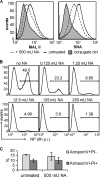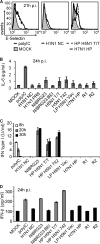Hemagglutinin-dependent tropism of H5N1 avian influenza virus for human endothelial cells
- PMID: 19812146
- PMCID: PMC2786827
- DOI: 10.1128/JVI.00468-09
Hemagglutinin-dependent tropism of H5N1 avian influenza virus for human endothelial cells
Abstract
Although current H5N1 highly pathogenic avian influenza viruses (HPAIV) are inefficiently transmitted to humans, infected individuals can suffer from severe disease, often progressing rapidly to acute respiratory distress syndrome and multiorgan failure. This is in contrast with the situation with human influenza viruses, which in immunocompetent individuals usually cause only a respiratory disease which is less aggressive than that observed with avian H5N1 viruses. While the biological basis of inefficient transmission is well documented, the mechanisms by which the H5N1 viruses cause fatal disease remain unclear. In the present study, we demonstrate that human pulmonary microvascular endothelial cells (hPMEC) had a clearly higher susceptibility to infection by H5N1 HPAIV than to infection by human influenza viruses. This was measurable by de novo intracellular nucleoprotein production and virus replication. It was also related to a relatively higher binding capacity to cellular receptors. After infection of hPMEC, cell activation markers E-selectin and P-selectin were upregulated, and the proinflammatory cytokines interleukin-6 and beta interferon were secreted. H5N1 virus infection was also associated with an elevated rate of cell death. Reverse genetics analyses demonstrated a major role for the viral hemagglutinin in this cell tropism. Overall, avian H5N1 viruses have a particular receptor specificity targeting endothelial cells that is different from human influenza viruses, and this H5N1 receptor specificity could contribute to disease pathogenesis.
Figures





References
-
- Abdel-Ghafar, A. N., T. Chotpitayasunondh, Z. Gao, F. G. Hayden, D. H. Nguyen, M. D. de Jong, A. Naghdaliyev, J. S. Peiris, N. Shindo, S. Soeroso, and T. M. Uyeki. 2008. Update on avian influenza A (H5N1) virus infection in humans. N. Engl. J. Med. 358:261-273. - PubMed
-
- Chan, M. C., C. Y. Cheung, W. H. Chui, S. W. Tsao, J. M. Nicholls, Y. O. Chan, R. W. Chan, H. T. Long, L. L. Poon, Y. Guan, and J. S. Peiris. 2005. Proinflammatory cytokine responses induced by influenza A (H5N1) viruses in primary human alveolar and bronchial epithelial cells. Respir. Res. 6:135. - PMC - PubMed
-
- Cheung, C. Y., L. L. Poon, A. S. Lau, W. Luk, Y. L. Lau, K. F. Shortridge, S. Gordon, Y. Guan, and J. S. Peiris. 2002. Induction of proinflammatory cytokines in human macrophages by influenza A (H5N1) viruses: a mechanism for the unusual severity of human disease? Lancet 360:1831-1837. - PubMed
-
- Danese, S., E. Dejana, and C. Fiocchi. 2007. Immune regulation by microvascular endothelial cells: directing innate and adaptive immunity, coagulation, and inflammation. J. Immunol. 178:6017-6022. - PubMed
-
- de Jong, M. D., C. P. Simmons, T. T. Thanh, V. M. Hien, G. J. Smith, T. N. Chau, D. M. Hoang, N. V. Chau, T. H. Khanh, V. C. Dong, P. T. Qui, B. V. Cam, Q. Ha do, Y. Guan, J. S. Peiris, N. T. Chinh, T. T. Hien, and J. Farrar. 2006. Fatal outcome of human influenza A (H5N1) is associated with high viral load and hypercytokinemia. Nat. Med. 12:1203-1207. - PMC - PubMed
Publication types
MeSH terms
Substances
LinkOut - more resources
Full Text Sources
Medical
Research Materials

